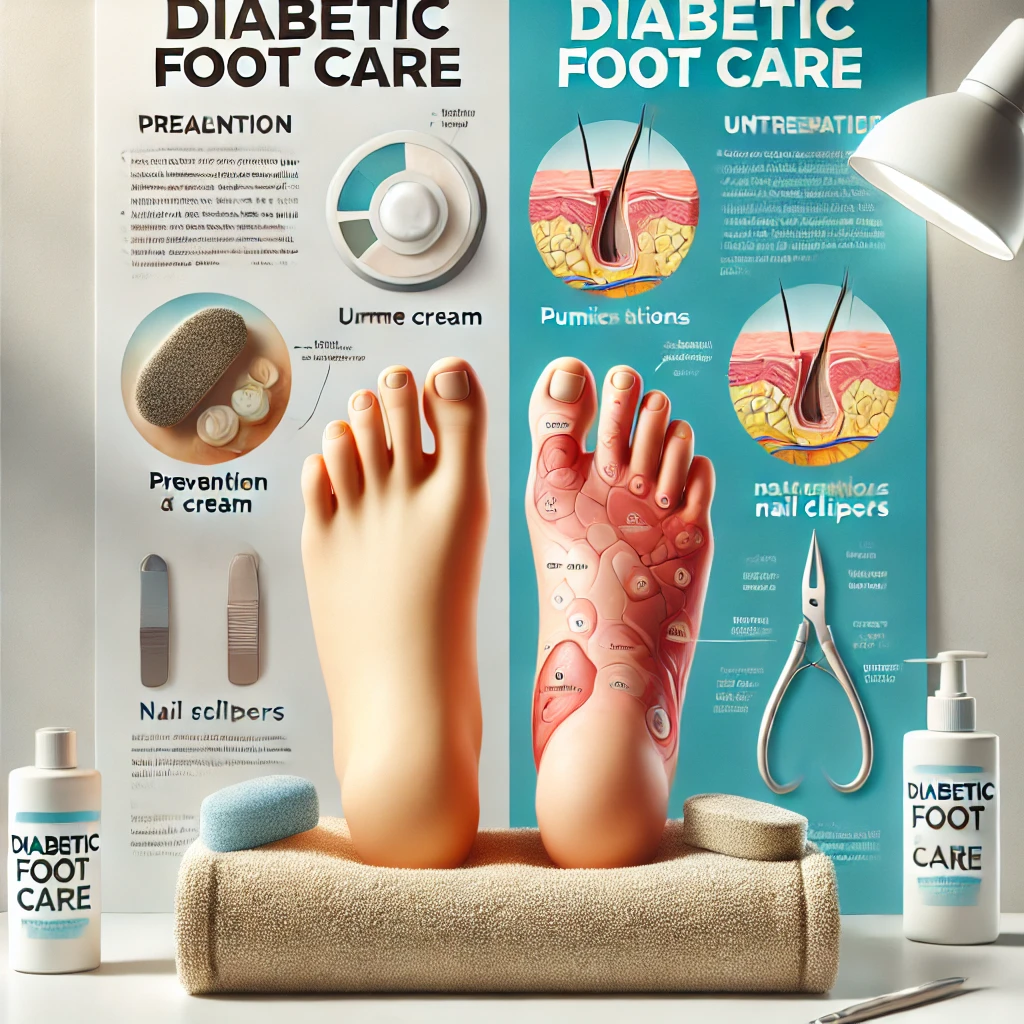For individuals living with diabetes, maintaining proper foot health is crucial. Diabetic foot care helps reduce the risk of severe complications such as infections, ulcers, or even amputations. With proper awareness and preventive measures, you can keep your feet healthy and minimize risks. In this blog, we’ll cover practical tips and strategies to ensure your diabetic foot care routine is both effective and sustainable.
What is Diabetic Foot Care?
Diabetic foot care refers to a series of preventive measures aimed at managing foot health in people with diabetes. Diabetes can cause reduced blood flow and nerve damage (neuropathy), which makes feet vulnerable to injuries, infections, and poor healing. Regular foot care ensures that minor issues don’t escalate into serious problems.
Why is Diabetic Foot Care Important?
Without adequate care, diabetes can lead to severe complications such as:
- Foot ulcers
- Infections that are hard to treat
- Gangrene (tissue death due to lack of blood supply)
- Amputations
Proper diabetic foot care significantly lowers the likelihood of these complications, enhancing the quality of life for individuals with diabetes.
Also Read: Are There Any Risks Associated with Varicose Veins Treatments?

10 Essential Tips for Diabetic Foot Care
Inspect Your Feet Daily
Check for blisters, cuts, sores, redness, or swelling. Use a mirror to examine the bottoms of your feet, or ask for help if you can’t see them clearly. Early detection of issues is critical.
Wash Your Feet Gently
Clean your feet daily with lukewarm water and mild soap. Avoid soaking them for long periods, as this can dry out the skin. Dry thoroughly, especially between the toes.
Moisturize, but Not Between Toes
Apply a good-quality moisturizer to keep your feet hydrated and prevent cracks. However, avoid applying lotion between the toes, as this can encourage fungal infections.
Trim Nails Carefully
Cut your toenails straight across to prevent ingrown nails. If you find trimming difficult or notice thickened nails, seek professional help from a podiatrist.
Choose Proper Footwear
Wear shoes that fit well and provide ample support. Avoid tight, ill-fitting shoes or high heels. Opt for diabetic-friendly footwear designed to minimize pressure and reduce the risk of injury.
Avoid Walking Barefoot
Whether indoors or outdoors, always wear shoes or slippers to protect your feet from cuts, burns, or other injuries.
Keep Your Blood Sugar Levels Under Control
Managing blood sugar is the cornerstone of diabetic foot care. Consistently high blood sugar levels can worsen circulation issues and slow healing.
Protect Your Feet from Extreme Temperatures
Avoid exposing your feet to extreme heat or cold. Always check the water temperature before dipping your feet into a bath, as neuropathy may impair your ability to sense heat.
Address Corns and Calluses Safely
Do not attempt to treat corns or calluses on your own with over-the-counter remedies, as these can cause burns or infections. Always consult a healthcare professional.
Schedule Regular Foot Exams
Visit your doctor or podiatrist regularly for a comprehensive foot check-up. They can identify potential problems early and recommend solutions tailored to your needs.
Also Read: Latest Treatments for Varicose Veins in 2024

Common Mistakes in Diabetic Foot Care
- Ignoring minor injuries: Even small cuts or blisters can become serious if neglected.
- Wearing tight socks: Always choose socks made from breathable materials, preferably seamless and non-restrictive.
- Overlooking symptoms of neuropathy: Tingling, numbness, or pain in your feet could indicate nerve damage.
Diabetic Foot Care Products Worth Considering
Several products can enhance your foot care routine:
| Product | Benefits |
|---|---|
| Diabetic socks | Minimize friction and improve circulation |
| Orthotic insoles | Provide support and reduce pressure |
| Antifungal creams | Prevent and treat fungal infections |
| Moisturizing foot creams | Maintain skin hydration |
| Diabetic shoes | Protect feet and improve comfort |
FAQs
What are the early signs of diabetic foot problems?
Early signs include redness, swelling, pain, and any changes in skin color or temperature. These symptoms should be evaluated promptly by a healthcare professional.
How often should I check my feet if I have diabetes?
You should inspect your feet daily, especially if you have a history of ulcers or neuropathy.
Can exercise help in diabetic foot care?
Yes, regular exercise improves blood circulation, which is essential for foot health. However, consult your doctor to choose safe activities.
Are pedicures safe for diabetics?
Pedicures can be risky due to potential infections or injuries. Always visit a podiatrist for professional care.

How do I choose the right shoes for diabetic foot care?
Look for shoes with a wide toe box, cushioned insoles, and breathable materials. Avoid pointed toes or high heels.
Is it safe to remove calluses at home?
No, attempting to remove calluses at home can lead to injuries and infections. Always consult a podiatrist for safe removal.
Also Read: How PAD Symptoms Differ from Regular Muscle Cramps: Key Differences Explained
Conclusion
Diabetic foot care is a vital part of managing diabetes effectively. By adopting these tips and being proactive about your foot health, you can reduce the risk of complications and maintain an active lifestyle. Remember, a little care goes a long way in preventing serious foot issues. Regular check-ups, proper footwear, and diligent hygiene are your best allies in keeping your feet healthy and pain-free.



